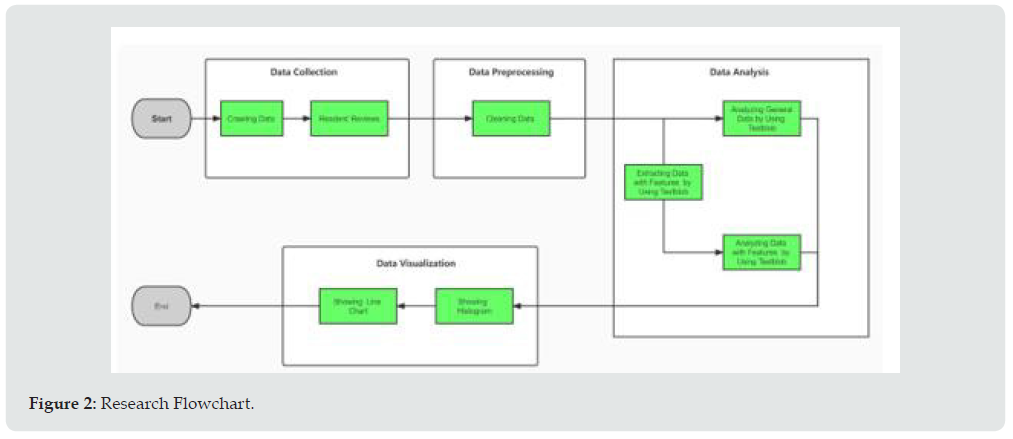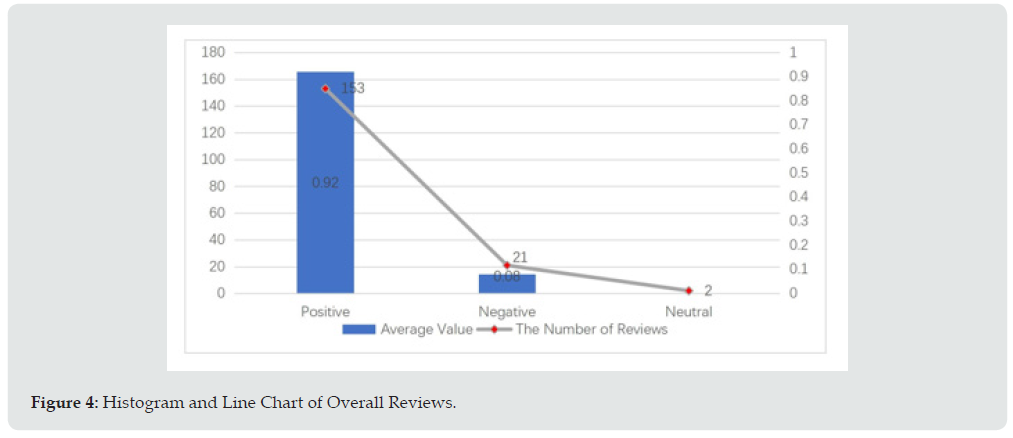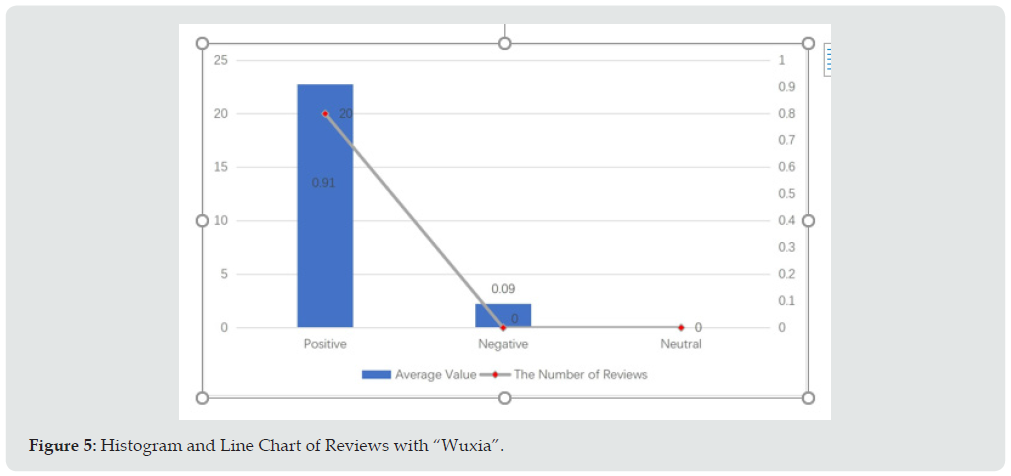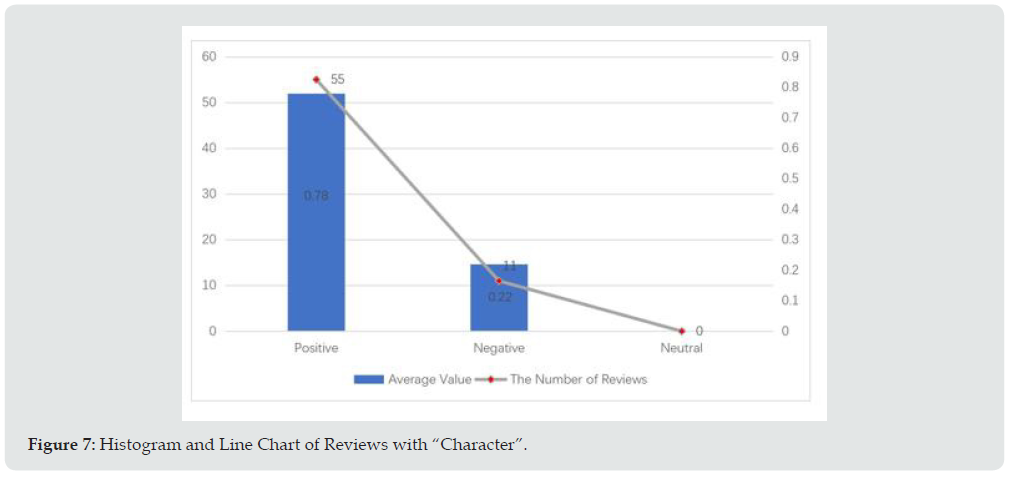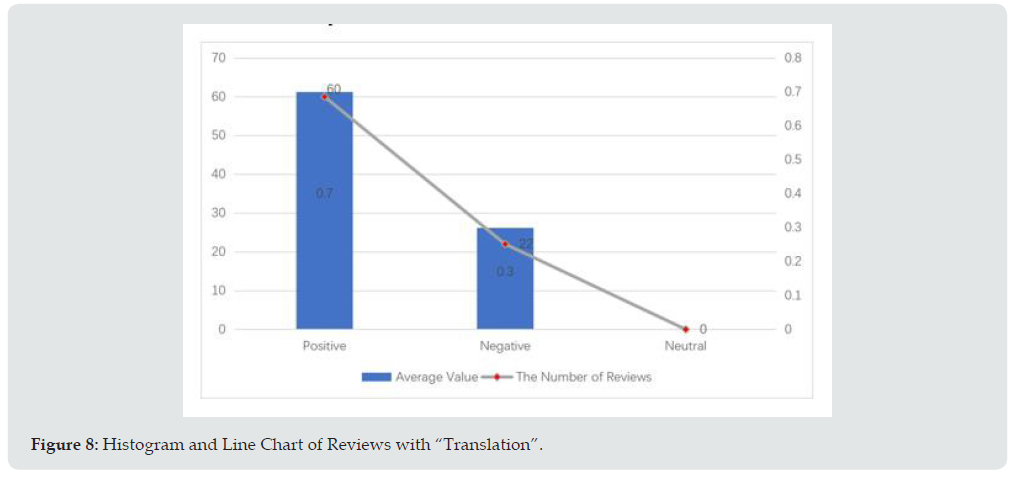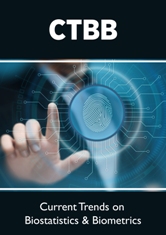
Lupine Publishers Group
Lupine Publishers
Menu
ISSN: 2644-1381
Research Article(ISSN: 2644-1381) 
Sentiment Analysis on Acceptance of A Hero Born-Legends of the Condor Heroes Based on TextBlob Volume 3 - Issue 4
Yonglan Li1* and Gong Zutong2
- 1School of Foreign Languages, Guizhou University of Finance & Economics, China
- 2School of Foreign Languages, Guizhou University of Finance & Economics, Huaxi District, Guiyang, Guizhou Province, PR China,550025
Received: May 12, 2022 Published: May 27, 2022
*Corresponding author: Yonglan Li, School of Foreign Languages, Guizhou University of Finance & Economics, China
DOI: 10.32474/CTBB.2022.03.000170
Abstract
Sentiment analysis is one of the most prominent areas of opinion mining in NLP. It helps researchers to extract valuable information from enormous amount of data for different purposes. Thus, it can be applied to identify the opinion or attitude of the consumers. The comments can be Positive, Neutral or Negative type. Based on a Python Sentiment analysis, this research collects data on the readers’ review of A Hero Born--Legends of the Condor Heroes from Amazon Web Site. The analysis focuses on the readers’ acceptance to the publication from four perspectives: theme, plot, character and language. We conclude that Chinese Wuxia literature has got great popularity and caught close attention globally.
Introduction
Sentiment Analysis extracts person’s opinions from the web and classifies these reviews as per the positive and negative for the particular organisation or the company associated [1]. Sentiment typically refers the emotions, feelings, opinions or attitude. With the rapid increase of World Wide Web, people often express their sentiments over internet through social media, blogs, rating and reviews [2]. These sentiments can be categorised either into two categories: positive and negative; or into an n-point scale, e.g., very good, good, satisfactory, bad, very bad [3]. Sentiment analysis is usually implemented on three levels namely sentence level, document level and aspect level. This study mainly concerns about document level, which aims at classifying the entire document (readers’ comments) as positive or negative [4]. For the first time, A Hero Born--Legends of the Condor Heroes was translated from Chinese into English by Anna Hollywood and published by MacLehose Press in 2018. Being called “A Chinese Lord of the Rings”, Legends of the Condor Heroes was originally published in the Chinese language as Shediao Yingxiong Zhuan in 1959. Since then, Louis Cha became the most widely read Chinese writer and his works have been regarded as a symbol of Chinese martial arts. Despite its popularity in Chinese world, there still remains some questions to be answered: To what degree did the English world pay the attention to the literature of Chinese martial arts? What’s the response the English readers may have to Cha’s Wuxia series? Our researchers collected the comments from Amazon Web Site and made an attempt to carry out a sentimental analysis based on Textblob, using NaiveBayes Analyzer. This may arouse the potential attention of both the publishing market and the translation studies. The paper has been organized as follows: Section 2 reviews the related works done earlier on sentimental analysis. Section 3 describes the methodology and procedure of the study. Section 4 reports the results. Section 5 presents the conclusions.
Related Works
According to Ronen Feldman, Sentiment analysis is defined as the task of finding the opinions of authors about specific entities [4]. At present, most of the applied research using sentiment analysis focuses on the investigation and judgment of social public opinions, and customer feedbacks for products. For example, Xu Lin & Mu Chunyu empirically examined the attitudes of netizens from Sina Weibo based on the incident of “no criminal responsibility for the death causing by an unmanned vehicle” through sentiment analysis [5]. Study has shown that there is a polarization of attitudes among these cyber citizens when making comments on this event - positive emotions are more scattered, while negative emotions are prone to clustering together, which reflects the concerns of netizens about the immaturity of unmanned technology and the legal dilemma brought about by unmanned vehicles. Shang Yongmin & Zhao Yuqin collected the comments of hot-selling laptops in JD.com, and used Naïve Bayes Classifier algorithm, Support Vector Machine (SVM) and Snow NLP approach to classify the sentiment of the data [6].
By comparing results of these three methods, the optimal classification approach for online comments’ sentiment is adopted. Up to now, Sentiment analysis approaches mainly include method of sentiment dictionary, machine learning, and deep learning. The method based on sentiment dictionary needs to establish a sentiment dictionary first, and then perform sentiment calculation based on it. The method based on machine learning needs to extract artificial features first, and then use machine learning algorithm to classify the sentiment of the texts. And the commonly used techniques include Naive Bayes Classifier algorithm, Support Vector Machine, Maximum Entropy, etc. In recent decades, with the further development of Chinese literature, the process of its translation has become an irresistible trend, and some literary works have also achieved remarkable success in overseas markets. According to the author’s statistics, as of January 27, 2022, there has been a total of 3,369 comments on The Three Body Problem translated by Liu Yukun on Amazon. At the same time, The Art of War translated by Ralph D. Sawyer and Lionel Giles has respectively gained more than 4,000 comments in total, and Yu Hua’s work translated by translators such as Michael Berry and Allan H. Barr has had also 300 reviews.
Though the availability of such huge data, it is difficult for researchers on translation introduction to draw a strong conclusion about readers’ attitude from complex comments, and the research process and results may be lack of objectivity and sufficient empirical support due to the large number of comments as well as the different content and opinions. However, sentiment analysis can be used to analyze reviewers’ opinions on a product or an event to obtain their exact attitude. When a person wants to buy a product online, he or she will typically start by searching for reviews and opinions written by other people on the various offerings. Therefore, this paper attempts to crawl the book reviews on Amazon for the A Hero Born--Legends of the Condor Heroes, and applies Python’s sentiment analysis toolkit--TextBlob into this research to classify English readers’ attitudes toward this book from these reviews, and then to summarize overseas acceptance of this novel.
Methodology and Procedure
Research Methodology
This research uses KDD (Knowledge Discovery And Data Mining) methodology to carry out the whole process. As articulated by Fayyad et al., the term “KDD” refers to the overall process of discovering useful knowledge from data, including how the data is stored and accessed, how algorithms can be scaled to massive datasets and still run efficiently, how results can be interpreted and visualized [7]. As depicted in (Figure 1) the methodology explains the KDD concept used for sentiment analysis on book review.
a) Data Selection
In this phase, a dataset should be selected to perform the discovery.
b) Data Preprocessing
During this phases, basic operations, such as removing noise, should be completed by using different Natural Language Processing (NLP) techniques.
c) Data Transformation
In this phrase, the dataset that has been appropriately preprocessed should be transformed into a format accessible to data mining.
d) Data Mining
This phrase includes adopting a suitable method that used for searching patterns in the data.
e) Interpretation/Evaluation
During this phase, the discovered patterns should be visualized and interpreted with understandable description.
Research Procedure
Based on the foregoing, the research flowchart was designed in the light of the methodology above as shown in Figure 2. And then, some main steps will be explained in detailed as follows.
Research Object
With the translation of Chinese novels developing, Wuxia novels have also emerged on overseas book-buying platforms, attracting the attention of foreign readers. A Hero Born, the first volume among the translations of Louis Cha’s novel Legends of the Condor Heroes, also sparked discussions among these readers, and one of its forms is to write book reviews on book-buying platforms. These book reviews are the data available to explore the specific emotional attitudes of readers. Therefore, this research took whole reviews of A Hero Born--Legends of the Condor Heroes from the Amazon of US as the research object. As of February 20, 2022, reviews for the first volume--A Hero Born on Amazon totaled 177. Moreover, all the above reviews were used and analyzed to obtain objective data in this study.
Data Collection
Data collection is also a crucial step to obtain accurate data. The section of book review from the Amazon’s all-reviews webpage is divided by different reviewers. Accordingly, the individual section of the reviewer is further subdivided into the following parts: the name of the reviewer, the brief introduction of the review content, the time of making comment, and the specific review content. In order to know about the readers’ attitudes towards the novel, it is necessary to obtain unabridged content of reviews, and also the brief introduction, for helping us choose features which will be discussed in detail later. Therefore, in collecting data, the researchers edited a web crawler using Python language to crawl all Amazon readers’ comments on A Hero Born--Legends of the Condor Heroes at 12:00 on February 20, 2022. At the moment, the web crawler gained 177 reviews with its brief introduction and reviewers’ name in total from 18 webpages. Furthermore, all data crawled from Amazon were stored in Excel.
Data Preprocessing
Language data has diverse characteristics. Before obtaining the final statistical results, it is necessary to carry out data cleaning, in order to reduce noise-heavy text data into cleaner version therefore prepare dataset for sentiment analysis. Unlike tweets, microblogs and other forms of text crawled from the Internet, the book review from Amazon is a relatively standard and formal kind of text without such noise as emojis, URLS. And also, the removal of unnecessary white spaces had been done in the phase of data collection, which used regular expression to merely match the content of reviews. Besides, the process of tokenization was to be completed by Naïve Bayes Analyzer, which will be introduced in next part, with its builtin function before data analysis. Furthermore, 1 review that uses non-English language was manually filtered out, and finally 176 reviews meet the research requirements for next phase.
Data Analysis
Textual sentiment analysis is a common method in text analysis, which can be used to judge film reviews, product reviews, public opinions, political inclinations, market forecasts, etc. This Paper will download the TextBlob toolkit from the open-source website GitHub and load it into the Python programmer PyCharm. There are two analyzers in TextBlob toolkit--patternanalyzer and NaïveBayesAnalyzer. The former is the default algorithm of TextBlob for sentiment analysis. Its result is available in two categories, i.e., polarity and subjectivity. Polarity can take value in between -1 to 1, and subjectivity, 0 to 1. In this regard, polarity equaling 0 indicates that the sentiment is neutral, -1 indicates highly negative and 1 indicates highly positive. On the other hand, 0 indicates that statement is high objective while 1 indicates highly subjective for subjectivity [8]. NaïveBayesAnalyzer is a NLTK classifier that is trained on a dataset of movie reviews, and its algorithm is shown in Figure 2. The result of NaïveBayesAnalyzer is available in three categories--classification, p_pos and p_neg. P_pos and P_neg both range from 0 to 1, and the sum of them equals 1. Classification is divided into positive, neutral and negative types. If the value of p_ pos is over 0.50, the classification indicates positive.
When p_pos and p_neg are same as 0.50, it indicates neutral. The classification indicates negative once p_pos is more than 0.50 (Figure 3). Algorithm of NaïveBayesAnalyzer In this research, we invoked NaïveBayesAnalyzer to analyze the data prepared before, in order to gain emotional types and values of the comments on A Hero Born--Legends of the Condor Heroes. However, the process above can only obtain readers’ overall evaluation. To obtain more detailed readers’ opinions, this research conducted feature extraction and analyzed data with features. Sentiment analysis of feature is a fine-grained analysis of the subjective text generated by the users towards features of objects’ attributes. A feature can be a component or attribute of an object reviewed. In terms of this phase, it is mainly extracted according to the frequency of nouns and noun phrases in the brief introduction that had been crawled. Based on the high-frequency nouns and noun phrases, this study further explored readers’ attitudes from the following four dimensions of subject, plot, characters, and translation. That is, 20, 22, 66, and 82 comments containing the keywords “Wuxia”, “plot”, “character”, and “translation” were extracted respectively, detailed sentences in regard to these keywords were picked out and then these 4 kinds of comments were analyzed through NaïveBayesAnalyzer to obtain results at the same time.
Results
Through using NaïveBayesAnalyzer, the number of different sentiment types is counted, and the result is shown in Table 1. Among all the comments on A Hero Born--Legends of the Condor Heroes, there are 153 comments classified as positive, accounting for about 87% of the total number of comments; only 2 neutral comments with detailed content of “OK”, accounting for about 1.1% of comments in total; and 21 comments classified as negative, accounting for about 11.9% of all comments. Reviews with feature-- “Wuxia” add up to 20, and all these reviews are classified as positive. There are 21 reviews with “plot”, including 16 positive reviews and 5 negative reviews. And the total reviews with “character” is 66, containing 55 positive reviews and 11 negative reviews. Moreover, nearly half of all comments focus on the translation. There are 60 positive reviews and 22 negative reviews.
Analysis Results of Overall Reviews
The results of the correlational analysis are displayed in Figure 4. In this mixed figure, the average value is illustrated by histogram with the specific values shown on the right side of the chart, and the number of reviews were illustrated by line chart with the specific values shown on the left side. Furthermore, the structure of mixed figures below is identical. In addition to the number of three sentiment types illustrated above, it can be found that the positive comments are accounting for about 87% of the total number of comments, while negative comments, around 11.9%. Through Naïve Bayes Analyzer, we are able to obtain the value of p_pos and p_neg, both of which can indicates the sentiment or attitudes of comments. Through analysis, the average value of these two indicators is calculated and shown in Figure 3. According to the figure, the average value of positive comments reaches about 0.92, which is far more than the negative average value of 0.08. From the data above, it can be concluded that overseas readers have widely accepted A Hero Born--Legends of the Condor Heroes. Besides, the authors selected 50 valid positive comments with the top 25% positive sentiment value, in order to further obtain the specific reasons why readers love.
After analysis, readers who made positive comments mainly concern themselves about the following aspects: excellent service of Amazon including delivery, vivid description of action scenes, and curiosity about Chinese culture. First, multiple readers showed their satisfaction with Amazon’s platform in parcel shipment when they made positive comments. Some readers said that book was arrived on time and was in good quality. Amazon is an excellent platform [9]. Some readers stated that when the book arrived, it was in good condition, and the exquisite packaging made him surprised. It was a great experience and greatly aroused his interest in reading [10]. It can be seen that the sales platform is also an important driving force for the dissemination of books. An influential and excellent platform can provide readers with high-quality services, allow more readers to have access to a variety of books, and play a positive role in promoting introduction of Chinese literary works.
Secondly, A Hero Born--Legends of the Condor Heroes is a long martial arts novel written by Louis Cha. There are countless fight scenes and many martial arts movements in the book, such as Nine Yin Skeleton Claw, Split Muscles Lock Bones, and Autumn Wind Blows the Fallen Leaves. As a reader recounted, there is great story telling along with some wonderful fight scenes [11]. And even some readers suggested that this novel is not same as a book, but a vivid martial arts movie. Finally, readers were curious about the history of the East, including China. A Hero Born--Legends of the Condor Heroes was based on the history from 1199 AD to the death of Genghis Khan (1227 AD). A reader commented that Chinese culture is so fascinating to him, and he found the world building to be so wonderfully written [12]. Even part of readers compared Legends of the Condor Heroes with Crouching Tiger, expressing their longing for the classic martial arts world of leaping onto roofs and vaulting over walls [13]. There are also readers who are drawn to Louis Cha’s adaptation of a true epic into a stirring story [14]. On the other hand, there also existed few negative comments on the novel, and most of them focused on character, translation, and descriptions of fight scenes. Regarding the dissatisfaction with the character and translation, the author will explain them in detail below. While many positive reviews expressed the love for the depiction of fight scenes, some readers felt that these scenes in the book were cookie-cutter and tedious [15]. A number of comments also mentioned that A Hero Born--Legends of the Condor Heroes did not deserve the title of Chinese Lord of the Rings, and they believed that this book was just a genre favored by readers who had a kung fu dream [16]. Therefore, in the process of publicizing translations, we must not over-hype it, otherwise the result will be counterproductive.
Analysis Results of Reviews with Features
Analysis Results of Reviews with “Wuxia”
After analysis, the average value of these two indicators is calculated and shown in Figure 5. According to the figure, the average value of positive comments reaches about 0.91, which is also far more than the negative average value of 0.09. Since there are no neutral and negative comments among these 20 reviews, it can be seen that all readers who made comments containing “Wuxia” expressed their love for martial arts novels. Some readers can be categorised as “regulars” of martial arts novels, and also recommend the Deer and the Caudron series translated by John Minford to other readers [17]. Moreover, a reader mentioned that she was influenced by martial arts movies as a child and yearned for the world in films. Based on history and reasonable imagination, Louis Cha combined myths and folklore, and brought a brand-new fantasy world to Western readers. This was what exactly made A Hero Born--Legends of the Condor Heroes so compelling [18]. More highly praised by readers, A Hero Born--Legends of the Condor Heroes is the pinnacle of martial arts novels [19]. In addition to “Wuxia” representing theme, many commenters use “Wuxia” directly to refer to experts who are proficient in martial arts, which also shows a positive attitude towards life.
Analysis Results of Reviews with “Plot”
Through analysis, the average value of these two indicators is calculated and shown in Figure 6. According to the figure, the average value of positive comments reaches about 0.77, and the negative average value is 0.23. It can be seen from the above that nearly three quarters readers made positive reaction to the plot, and most of them considered the plot was “detours”, “exciting”, “pageturning” and “full of twists and tension”. Some readers suggested that Legends of the Condor Heroes had a coherent design in plot, which injected vitality into the novel from beginning to end [20]. The main plot line revolved around Guo Jing, while a large number of subplots made this novel more like a heroic epic [21]. And the key to martial arts novel is its plot. Even regardless of fight scenes, it is still a high-quality book depending on the plot alone [22]. Some readers even bluntly stated that Louis Cha, like JR Tolkien and JK Rowling, is a master of creating otherworldly worlds, and the novel is full of fascinating plots [23]. They also found that elements of political
intrigue included in Legends of the Condor Heroes also made the story more interesting [24]. Of course, there were some different opinions. Readers who made negative comments thought that the plot development is too fast to catch up and is simplistic, which can’t allow them to gain the same feeling of entering the world of martial arts [25]. There was also a reader who felt that the plot span of the entire novel was too small and expected to see a plot spanning several centuries [26]. What was more prominent was that many comments mentioned that the progress of the plot was highly accidental. Unlike Westerners’ mindset, many interpersonal behaviors in the novel were driven by fleeting whimsy, without purpose. And the end of the story, whether on the main plot line or the subplot, felt like it was not over yet. For example,the author put an important character at risk of death, and then nothing happened [27].
Analysis Results of Reviews with “Character”
Shown in Figure 7 above, the average value of positive comments reaches about 0.78, and the negative average value is 0.22. And the positive comments are 5 times more than the negative ones. After comparison, it was found that the novel received many critical reviews towards character setting. First, the vast majority of readers who made negative comments believed that there were too many characters in the novel, and most of their names were literally translated from Chinese pinyin, making it difficult to match
specific characters with names [28]. Second, the character setting and its subsequent development were anemic, and the description of characters was superficial. For example, the scenes with the Seven Heroes were dragging in the same way of a television show who lets every character speak in every scene. The reader also found the fight scenes where there are more than two fighters to be rather boring because of
how many people had to be featured and their actions explained before moving on [29]. Finally, comments suggested some characters are immature. They are proficient in martial arts, but cannot control their personal emotions, and the characterization is slightly contradictory [30]. However, readers who liked character setting of Legends of the Condor Heroes often referred to the adjective “bizarre” in positive sentiment reviews. Although the names of the characters are weird, many readers said that new readers could refer to a helpful list of the main characters included in the front of the book. And as the progress of plot, the names would be familiar to them [31]. According to a reader, Legends of the Condor Heroes was a character-driven novel, and the connections between characters were important [32]. Furthermore, what really appealed to most readers was how the characters work hard and believed that what they did could fight against evil [33].
Analysis Results of Reviews with “Translation”
According to Figure 8, the total reviews with “translation” were 82, of which 60 were positive comments, with an average value of 0.7; and there were 22 negative comments with an average value of 0.3, which accounted for one third of the positive ones. Among the more than 170 comments, there were more than 80 comments containing the keyword “translation”, which showed that readers paid great attention to the quality of translation. The English translation of the first volume of Legends of the Condor Heroes was started by senior translator Anna Holmwood and the process of it lasted 6 years. The story was of a great deal of information and long, and it was too laborious to complete it alone. Therefore, she asked Gigi Chang to help with the relay. Under the circumstances, the English translations of Legends of the Condor Heroes were translated by two translators, Anna Holmwood and Gigi Chang. The former was responsible for volume one and three, and Chang was to translated volume two and four. After carefully analyzing the comments about Anna’s translation, the positive sentiment mainly focused on the following aspects: First, the translator’s writing was fluent and easy to read [34]. Second, the language was not westernized too much, but the words and phrases that represent Chinese culture were preserved; the language was deceptively simple, yet poetic [35]. Moreover, the translator tried to maintain the spirit of the original work, rather than literally translating the names of people and movements, which not only conveyed the full meaning and subtleties of the story, but also retained the rhythm and atmosphere of the original, delivering the visual experience and dialogue content as close to the original as possible. Finally, translator provided rich background and annotations for the terms in the text so that foreign readers could easily understand. And readers who made negative comments all believes that the beauty of literature lost in the process of translation [36]. When we took a further investigation into the reviews of next three volumes of Legends of the Condor Heroes, we found that the second, third and fourth volumes had a cliff-like decline in the number of reviews on Amazon compared to the first volume. Therefore, we need to reflect on whether the sudden drop in the number of comments is also related to the translator’s switch back and forth? After all, every translator has distinctive style from other translators. As for a series of novels with a continuous plot but separate volumes, readers who adapted to one translator’s style and then adapted to a new translator’s translation would inevitably experience discomfort or lost interest in reading. Is there such a possibility? We need take further research.
Conclusion
Through the analysis above, the translation of Legends of the Condor Heroes’ first volume has achieved success to a certain extent, both from overall and feature-based reviews. From the authors’ opinions, there are many reasons for the success, and all of them are indispensable. First of all, compared to the vast majority of foreign readers, martial arts novels with local Chinese characteristics are unfamiliar. Out of curiosity about new things, the theme can be said to be the steppingstone for the successful translation and introduction of Legends of the Condor Heroes. Secondly, as far as the original work is concerned, the plot and character setting are the soul of the novel. Only good stories can attract readers. As a martial arts novel that was once popular in China, Legends of the Condor Heroes has no doubts about its potential to become an international bestseller. Finally, it is the translator’s skill and patience. Gigi Chang once talked about how to overcome difficulties in translation, such as translating ancient rhetoric, grammar and sentence patterns in Louis Cha’s novels with reference t Shakespeare’s language style. It can be seen that the translator also contributed a lot in the process of translation and introduction. At the same time, the high acceptance of A Hero Born--Legend of the Condor Heroes overseas also shows that only by integrating global trend with national characteristics can foreign readers truly accept Chinese works.
Data Availability
The data that support the findings of this study are available upon request.
Conflicts of Interest
The authors declare that they have no competing interests.
References
- Lal M, Kumari R, Jain R, Rachna Jain, Preeti Nagrath (2020) Sentiment classification based on public reviews of different states towards the police. In Proc of the International Conference on Innovative Computing and Communication (ICICC) p. 1-7.
- Tripathya A, Agrawalb A, SK Rath (2015) Classification of Sentimental Reviews Using Machine Learning 3rd International Conference on Recent Trends in Computing (ICRTC-2015), Procedia Computer Science 57(10): 821-829.
- Prabowo R, Thelwall M (2009) Sentiment analysis: A combined approach. Journal of Informetrics 3(2): 143-157.
- Feldman R (2013) Techniques and applications for sentiment analysis. Communications of the ACM 56(4): 82-89.
- Xu L, C MU (2021) A Survey of Netizens' Attitudes towards Self-driving: A topic Model and Sentiment Analysis Based on Microblog Data. Journal of Hangzhou Dianzi University (Social Sciences) 17(6): 72-76.
- Shang Y, Zhao Y (2021) Sentiment Analysis and Implementation of Online Reviews Based on Machine Learning. Journal of Dali University 6: 80-86.
- Fayyad U, Piatetsky G, Shapiro, Smyth P (1996) The KDD process for extracting useful knowledge from volumes of data. Communications of the ACM 39(11): 27-34.
- Gujjar JP, HR PK (2021) Sentiment Analysis: Text Blob For Decision Int J Sci Res Eng Trends 7(2): 1097-1099.
- Sophie (2018) Customer review [EB/OL].
- Joshua Flick (2018) Customer review [EB/OL].
- Bill L (2020) Customer review [EB/OL].
- Cherilyn Spencer (2019) Customer review [EB/OL].
- Bentley (2017) Customer review [EB/OL].
- Theo Van Stratum (2019) Customer review [EB/OL].
- Montzalee W (2019) Customer review [EB/OL].]
- Just a person (2018) Customer review [EB/OL].
- Michael (2018) Customer review [EB/OL].
- Kelly (2019) Customer review [EB/OL].
- Ezequiel Davidovich Caballero (2018) Customer review [EB/OL].
- Dee Arr (2019) Customer review [EB/OL].
- Sheiglagh (2019) Customer review [EB/OL].
- MM (2018) Customer review [EB/OL].
- P Kimel (2018) Customer review [EB/OL].
- Karoline (2018) Customer review [EB/OL].
- Mongoose (2021) Customer review [EB/OL].
- Nancy or Rich (2019) Customer review [EB/OL].
- Russell (2018) Customer review [EB/OL].
- John Bourhis (2020) Customer review [EB/OL].
- Jjstiv (2019) Customer review [EB/OL].
- Tonstant Weader (2020) Customer review [EB/OL].
- Duomo (2018) Customer review [EB/OL].
- Traveling Cloak (2018) Customer review [EB/OL].
- Traveling Cloak (2021) Customer review [EB/OL].
- Jasmine (2020) Customer review [EB/OL].
- Matthew Mclaughlin (2019) Customer review [EB/OL].
- Kindle Customer (2021) Customer review [EB/OL].

Top Editors
-

Mark E Smith
Bio chemistry
University of Texas Medical Branch, USA -

Lawrence A Presley
Department of Criminal Justice
Liberty University, USA -

Thomas W Miller
Department of Psychiatry
University of Kentucky, USA -

Gjumrakch Aliev
Department of Medicine
Gally International Biomedical Research & Consulting LLC, USA -

Christopher Bryant
Department of Urbanisation and Agricultural
Montreal university, USA -

Robert William Frare
Oral & Maxillofacial Pathology
New York University, USA -

Rudolph Modesto Navari
Gastroenterology and Hepatology
University of Alabama, UK -

Andrew Hague
Department of Medicine
Universities of Bradford, UK -

George Gregory Buttigieg
Maltese College of Obstetrics and Gynaecology, Europe -

Chen-Hsiung Yeh
Oncology
Circulogene Theranostics, England -
.png)
Emilio Bucio-Carrillo
Radiation Chemistry
National University of Mexico, USA -
.jpg)
Casey J Grenier
Analytical Chemistry
Wentworth Institute of Technology, USA -
Hany Atalah
Minimally Invasive Surgery
Mercer University school of Medicine, USA -

Abu-Hussein Muhamad
Pediatric Dentistry
University of Athens , Greece

The annual scholar awards from Lupine Publishers honor a selected number Read More...





